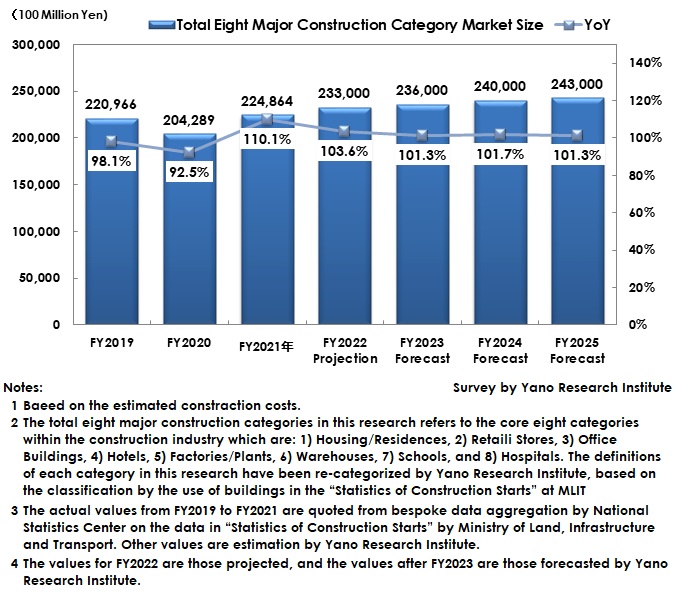No.3221
Total Eight Major Construction Categories Market in Japan: Key Research Findings 2023
Total Market Size of Domestic Eight Major Construction Categories Rose by 10.1% on a YoY Basis to 22,486,400 Million Yen
Yano Research Institute (the President, Takashi Mizukoshi) carried out a survey on the total market of domestic eight major construction categories and found out the total market size, trends by each category, and future perspectives.

Market Overview
The total eight major construction category market (total of eight categories: housing, retail stores, office buildings, hotels, factories/plants, warehouses for logistics, schools, and hospitals) for FY2021 increased to 22,486,400 million yen, 110.1% of the previous fiscal year, based on the estimated construction cost.
FY2021 saw recovery in housing, because of encouragement to obtain residence by the government such as partly continued housing supports in association with the FY2022 revised tax system, in addition to the reactionary rise from FY2020 when the construction demand sharply dropped amid the corona crisis. Furthermore, the expanded demand for office buildings, factories/plants, warehouses led the total market of eight major construction categories to a double digit growth of 110.1% from the previous fiscal year.
Noteworthy Topics
Measures to Labor Shortage
According to MLIT (the Ministry of Land, Infrastructure and Transport), of three million skilled construction workers nationwide, 530 thousand are 65 years of age or older (*1).
The challenge is to how to cope with construction labor shortage, in the situation where elderly workers are expected to retire one after another during the next decade while it is difficult to increase young generation. In addition, workers from overseas have decreased, because of the entry restrictions caused by corona crisis and of the decreased attraction for wages in Japan due to weakened yen.
As a measure against labor shortage, the construction industry is tackling to improve wages. Other than that, the industry is working to mechanize workflows and to improve work efficiency. In addition to technological development in construction methods of no human intervention, how to share and pass over the construction technologies and knowhow accumulated in the past are the crucial theme.
*1: “Reference Material 1: Situation surrounding the Recent Construction Industry, for The First Deliberations Committee on Environment for Sustainable Construction Industry (3 August 2022)” by MLIT.
Future Outlook
The total eight major construction category market (total of eight categories: housing, retail stores, office buildings, hotels, factories/plants, warehouses, schools, and hospitals) for FY2022 based on the estimated construction cost is likely to expand by 3.6% to 23,300,000 million yen, due to higher construction expenses accompanying rising commodity prices.
As the domestic economy picked up in FY2022 because both of the measures against the corona crisis and proactive economic activities, the private sector non-housing construction investment continued to recover, according to MLIT (*2).
The total market of eight major construction categories (total of eight categories: housing, retail stores, office buildings, hotels, factories/plants, warehouses, schools, and hospitals) for FY2025 is projected to be 24,300,000 million yen, 108.1% of FY2021, based on the estimated construction cost.
Until FY2025, in addition to redevelopment projects are scheduled at metropolitan city centers and at local cities, capital investment demand has been vitalized due to returning of investment to the domestic manufacturing industry. Furthermore, with World Expo to be held in Osaka and an integrated resort (IR) to open in and after 2025, the total market for eight major construction categories until FY2025 is projected to remain stable.
*2: “The Estimates for Construction Investment (FY2022)” by MLIT.
Research Outline
2.Research Object: Major eight categories within the construction industry: housing, retail stores office buildings, hotels, factories/plants, warehouses, schools, and hospitals
3.Research Methogology: Information collected through documents and publicized data by expert researchers, analysis based on bespoke data aggregation by National Statistics Center on the data in “Statistics of Construction Starts” by Ministry of Land, Infrastructure and Transport.
What is the Total Eight Major Construction Category Market?
The total market of eight major construction categories in this research refers to the core eight categories within the construction industry which are: 1) Housing/Residences, 2) Retail Stores, 3) Office Buildings, 4) Hotels, 5) Factories/Plants, 6)Warehouses for logistics, 7) Schools, and 8) Hospitals. The definitions of each category in this research have been re-categorized by Yano Research Institute, based on the classification by the use of buildings in the “Statistics of Construction Starts” at Ministry of Land, Infrastructure and Transport. All the categories include the new constructions as well as extension and remodeling of buildings. The market size is based on the estimated construction expenses. The actual values from FY2019 to FY2021 are quoted from bespoke data aggregation by National Statistics Center on the data in “Statistics of Construction Starts” by Ministry of Land, Infrastructure and Transport. Other values are estimation by Yano Research Institute.
<Products and Services in the Market>
Housing, retail stores, office buildings, hotels, factories/plants, warehouses for logistics, schools, and hospitals
Published Report
Contact Us
The copyright and all other rights pertaining to this report belong to Yano Research Institute.
Please contact our PR team when quoting the report contents for the purpose other than media coverage.
Depending on the purpose of using our report, we may ask you to present your sentences for confirmation beforehand.